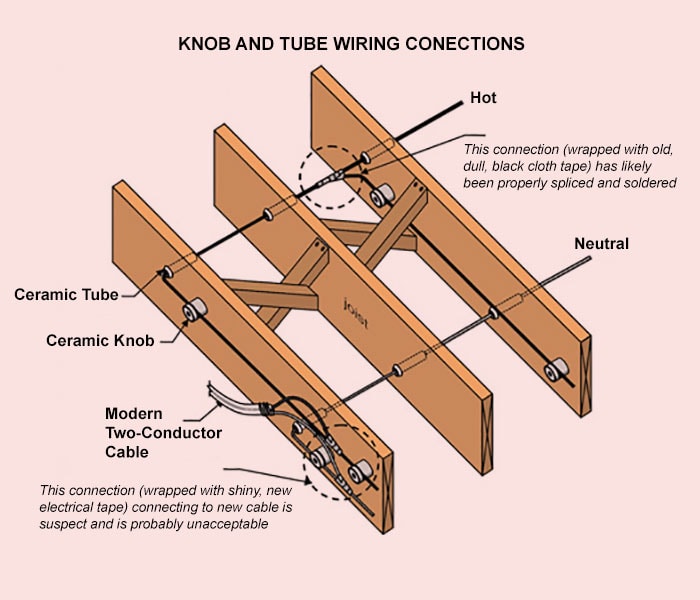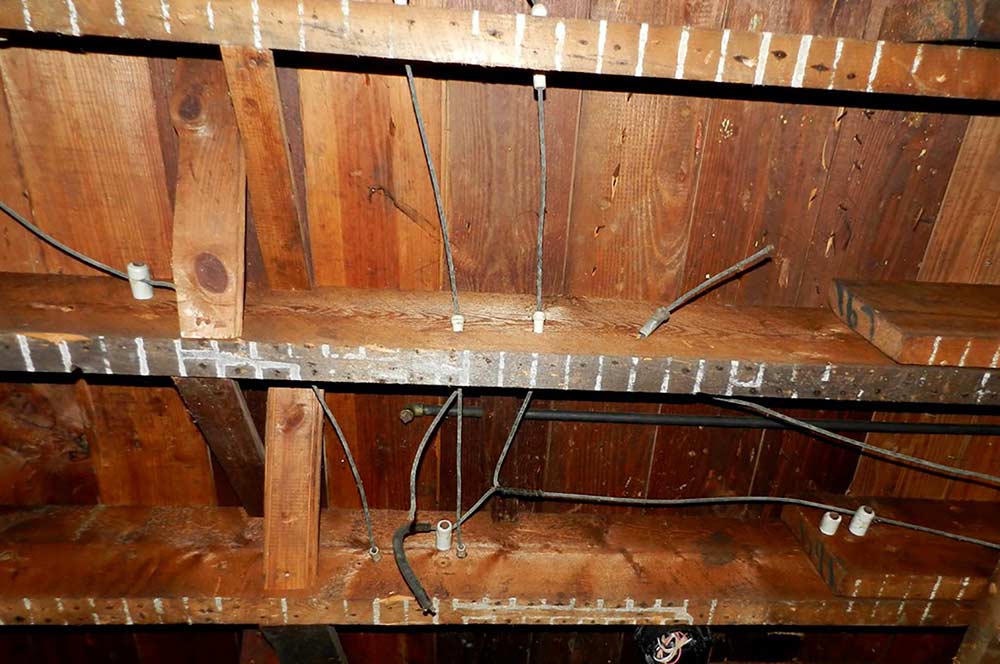Buying a vintage home is an incredibly exciting opportunity. You have a new home with a heritage deep in history, and you're beginning a new chapter in its life.
Purchasing an old house does, however, come with some drawbacks. Consider the wiring, for example. If your house was built before 1940, there's a chance it could be wired with old-fashioned knob and tube wiring.
There are a few problems with this type of wiring. First of all, it can be dangerous and lead to fires in certain scenarios. Your bigger problem, however, is that you'll find it becoming a problem when you're shopping for home insurance.
If you're a landlord, knob and tube wiring might cause some problems for you as you look for the best landlord insurance for your new property.
What is Knob and Tube Wiring?
Knob and tube wiring was a standard method of electrical wiring in buildings between the late 1880s and the late 1930s. It consists of a series of copper conductors that run through wall or ceiling cavities via an insulating tube made of porcelain. The wiring is nailed down and supported by white knobs, also made of porcelain.
Eventually, this form of wiring was slowly phased out of use as it was expensive to install, and better and more modern electrical systems were put into place in homes across North America.
The biggest difference between old knob and tube wiring and more modern wiring is that knob wiring has no ground wire. This means that there isn't as much protection against being shocked if you touch the wire. It also means it's more likely to cause a fire.
Most knob and tube wiring systems end up being replaced because their insulation, made of either porcelain or rubber, will eventually begin to wear away, and the wiring will be exposed.
Knob and tube wiring is often a deal-breaker when it comes to selling the house, as potential buyers usually won't trust an outdated wiring system that could pose a danger to them or the house.
How Does Knob and Tube Wiring Work?
Knob and tube wiring consists of copper wires that pass through insulating knobs and tubes. The copper wiring was usually made up of two wires, one hot and one neutral.
The knobs are there to hold the wiring in place, and the tubes prevent the wires from fraying or coming into contact with wood or anything else that could start a fire if it was overheated.
When the conductors were fed into appliances like lamps and switches, they would be protected by an insulating cloth known as loom.
When Did They Stop Using Knob and Tube Wiring?
Knob and tube wiring was the best way of wiring buildings in the years between 1880 and 1930. By the 1940s, it had begun to be phased out of regular use as it was slowly replaced with more modern wiring systems that would bundle hot and neutral cables as well as provide grounding.
It is extremely rare to find a house constructed after 1950 with this outdated knob and tube wiring style.
Is it Bad To Buy A House Using Knob and Tube Wiring?
You shouldn't dismiss a house outright solely because it has knob and tube wiring, but there are a few things you will need to do.
First of all, get the house inspected and looked over by an electrician who can assess the wiring. Sometimes the old wiring is left in the house but is no longer being used.
If the knob and tube wiring is still being used then you might need to get it replaced. Most insurance companies will require you to replace the old wiring within 60 days or they won't offer you insurance.
Risks Associated with Knob and Tube Wiring
Knob and tube wiring is not out and out dangerous, but it is considered a lot less safe than more modern types of wiring.
Because of its advanced age, the insulation tubes slowly deteriorate over time. If the tubes deteriorate enough, the wires could become exposed and pose a significant fire risk to the property.
There are five main risks associated with this wiring.
Brittle Insulation
Over time, the tubes used to insulate the copper wiring become brittle. This is because they are made of porcelain, which slowly loses its strength over time.
If the insulation becomes brittle, it can begin to crack and flake off, leaving exposed wires that can cause fires if they're close enough to wood or any other flammable material.
Alterations
The majority of the problems that people face with their knob and tube wiring stem from improper DIY alterations made to the wiring. With this system being so old and essentially obsolete, it can be hard to find replacement parts when components of the system break.
This leads to people making a lot of improvised and potentially dangerous alterations to their system. Some people splice the old tube wiring into the new wiring in the house, which creates dangerous situations.
Damage
Damage causes serious safety concerns with these systems. If either time, work, or any other incident manages to damage the porcelain tubing, you'll be left with frayed and exposed fires that can easily cause fires or shocks when touched.
Excess Use
You must remember that K&T wiring systems were most popular when houses didn't have that many electrical components to power. At most, the system had to power the lights, the telephone, and perhaps a radio.
The system isn't designed to be able to handle the sheer amount of power that runs through most modern wiring systems. TVs, phone chargers, games consoles, washers, dryers, and other appliances pose a significant risk to the system's functionality.
If the wiring cannot handle the amount of power running through it, it will begin to overheat and combust, posing a fire risk to your home.
Insulation Over the Wiring
Household insulation is made of incredibly combustible fiberglass material. If this type of home insulation is unwittingly installed over the copper wires from your K&T system, then your basement or attic essentially becomes a giant tinderbox.
The heat produced by electricity needs a lot of space to disperse to stop it from becoming a threat. Home insulation will impede this process and create a dangerous situation.
Another safety point to consider is whether or not your K&T wiring is near any of the water systems in your house. Exposed wiring and water is not a combination you want happening in your home.
Get the Coverage You Want at the Best Rates
Start considering what kind of legacy you can leave behind for your loved ones.
Get a Life quoteHow to Maintain Your Knob and Tube Wiring
If you want to carry on using your knob and tube wiring, you need to make sure to keep it properly maintained and always be vigilant for any signs of damage or fault.
Some things you can do to keep on top of your K&T wiring are:
- Get a qualified electrician to assess the installation of the system and any alterations that may have been made. They are the only people who can determine this with accuracy.
- Take care not to overburden the system, as this can lead to overheating and fire.
- Replace your outlets with GFCI outlets. These are three-pronged outlets that come with a reset button.
- Always replace cracked or damaged wiring or insulation
- Never use knob and tube wiring systems in kitchens, washrooms, or laundry rooms. You can only use grounded wiring in these rooms.
- Re-wiring is expensive and time-consuming, but faulty wiring can be hazardous and send insurers running.
- Carefully assess your options when you're deciding whether or not to rewire your home.
- If you find any home insulation surrounding your knob and tube wiring system, get an electrician to remove it immediately.
- Before buying a house that has knob and tube wiring, get an estimate of how much it will cost to get the wiring replaced. You can use this when negotiating a lower price.
Knob and Tube Wiring Replacement Cost
The cost of rewiring your entire house largely depends on a few factors. The price will be affected by the size of the house, the amount of wiring, how accessible the wiring is, and the overall age and condition of your property.
You should always seek out the help of an experienced and qualified electrician who can come take a look at the wiring and the property and will be able to give you a reasonable quote for the cost of replacing the wiring.
What Is the Life Expectancy of Knob and Tube Wiring?
When these wiring systems were first installed, they were specifically designed to last a long time. The copper wiring used in the systems can last up to a century.
The porcelain on the insulation tubes and knobs was designed to last a long time, too, but they do deteriorate and grow brittle over time through damage and natural degradation. When the insulation gets brittle, it starts to crack and flake off and expose the wires.
It's always recommended that you replace your insulation the moment that you see it beginning to go brittle and crack.
If you decide to replace the entire system, you'll end up making your home safer and more attractive to potential buyers. As mentioned above, the cost of this replacement depends on a few factors, but it shouldn't be ridiculously costly.
Knob and Tube Wiring FAQs
Below are the commonly asked questions online:
If you're unsure whether your home has knob and tube wiring, you can tell by carrying out a visual inspection.
You'll most often find it in the loft or the basement. Check floor joists in both of these rooms. If you notice white porcelain knobs nailed to the joists with dark copper wiring running through them, then it's almost certain that you have knob and tube wiring in your home.
There's a chance that you'll still have tube wiring without seeing any of these signs, so you should always try to conduct a thorough survey of your house to find out what type of wiring you have.
If something goes wrong with your knob and tube wiring, the first thing you should do is contact an experienced and qualified electrician to come and take a look at the system.
If you're seriously concerned about any problems with the system, you can look at having it replaced. There are pros and cons to replacing the wiring as it can be a complicated task, but faulty wiring can lead to fires and damage, and insurers won't want anything to do with your house.
Ready to Learn About Poly B Plumbing?
Learn more about it here.
View articleKnob and Tube Wiring and Your Home Insurance Company
Your insurance company always wants to know what type of wiring your home has, even if it doesn't have knob and tube wiring. It's likely that they'll also want to know how much of the house is powered by this kind of outdated wiring.
Some insurance companies will see K&T wiring as far too great of a risk, and they will refuse to insure your property unless you agree to have the wiring replaced within 60 days. Generally speaking, knob and tube wiring is one of the biggest challenges of buying an old house, and insurers are skittish about it.
However, not all companies will flat out refuse to insure a property that has knob and tube wiring. But it's worth bearing in mind that even the insurers who don't refuse you will probably hike your premium up because of the wiring you have.
At Insurdinary, we believe that everyone has the right to top-quality home insurance. If your home has K&T wiring and you're confused about what your insurance options are, get quotes from us today to see what's out there for you.








